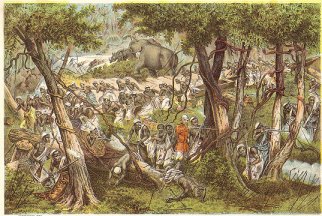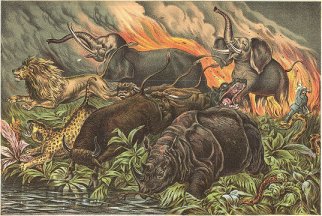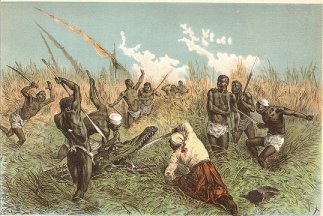"Feral children, also known as wild children or wolf children,
are children who've grown up with minimal human contact, or even none at
all. They may have been raised by animals (often wolves) or somehow survived
on their own. In some cases, children are confined and denied normal social
interaction with other people." ~ Feral Children Site (lost)
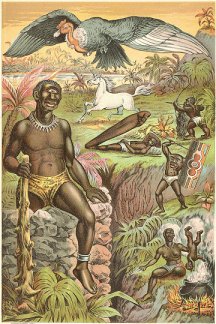 Occasionally
throughout our history, civilized society has come across a "wild child"
who has grown up in isolation with virtually no human contact. Many
researchers believe that we're born with the principles of language, but
if a first language isn't acquired by puberty it may be too late -- we
just don't have the neurological development. It also appears that there's
a particular period in the life of humans when they're ripe for learning
languages. Studies of feral children who have had little contact with humans
during the critical ages of one through four years show that they've had
tremendous difficulty mastering language and reintegrating with humans.
Occasionally
throughout our history, civilized society has come across a "wild child"
who has grown up in isolation with virtually no human contact. Many
researchers believe that we're born with the principles of language, but
if a first language isn't acquired by puberty it may be too late -- we
just don't have the neurological development. It also appears that there's
a particular period in the life of humans when they're ripe for learning
languages. Studies of feral children who have had little contact with humans
during the critical ages of one through four years show that they've had
tremendous difficulty mastering language and reintegrating with humans.
Languages are complex and dynamic -- constantly evolving according to
the needs of societies. To some degree humans appear to have the innate
ability to form languages and many feral children learn to mimic animal
sounds: barking, growling, whining, howling, bird sounds, etc., But research
suggests that it takes the interaction with other humans to develop a form
of communication with any degree of complexity. We are the result of complex
interactions between the environment and our genes.
Many of the "wild children" raised in isolation are found to be quite
uncivilized and barely able to walk or talk. They are unable to empathize
with of the needs and desires of other humans -- they don't even identify
themselves as human. The concepts of morals, property and possessions are
alien to them. Many of them prove to be surly, uncooperative and self-centred
individuals -- a far cry from the Noble Savage notion put forth by Jean-Jacques
Rousseau.
A study of feral children suggests that our upbringing is entirely responsible
for endowing us with language, the ability to think and other traits. What
happens in early childhood thus has a profound impact on the neurological
development of the brain:
"Studies of childhood abuse and neglect have important lessons for
considerations of nature and nurture. While each child has unique genetic
potentials, both human and animal studies point to important needs that
every child has, and severe long-term consequences for brain function if
those needs are not met. The effects of the childhood environment, favorable
or unfavorable, interact with all the processes of neurodevelopment."
~ Dr Bruce D Perry, Childhood
Experience and the Expression of Genetic Potential
"The importance of early intervention and attention to the chronicity
of environmental adversity may indicate the need for permanent alternative
caregivers, in order to preserve the development of the most vulnerable
children. . . . Child abuse and neglect are (wo)man-made phenomena which
adversely affect a child's development and sometimes survival, and which
should, at least in theory, be preventable."
~ Danya Glaser, Child
Abuse and Neglect and the Brain
Obviously research studies in this field are of major importance to
educators to whom a knowledge of language, moral, and overall neurological
development of students of all ages is of vital concern when designing
educational programs and instructional techniques. The Internet is an ideal
forum for the collation of related articles and research on this subject.
Until now there has never been an attempt made to scan the rare early writings
on the subject of feral children, so as to present them to researchers
at one location for open access study.
The most famous feral child in fiction is probably Edgar Rice Burroughs'
Tarzan. The character was introduced in Burroughs' 1912 novel, Tarzan
of the Apes, and soon became a cultural icon. John "Tarzan" Clayton,
the young orphan of Lord and Lady Greystoke, was raised by an advanced
"missing link" tribe of anthropoids in the African jungles. He learned
their rudimentary language as a young child and later taught himself to
read from his dead parents' collection of primers and other children picture
books -- an interesting case study. Using this fictional character as a
rallying point I have worked with Dr. Georges Dodds of McGill University
to present and document almost 100 feral-related works that inspired this
literary phenomenon. I believe that the discovery and perusal of these
many thousands of pages and illustrations will serve as an impetus for
further research in the field.
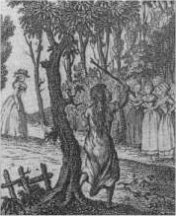
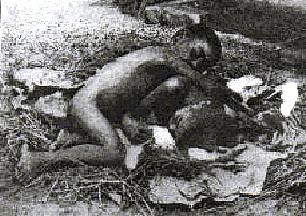

William G. Hillman
Assistant Professor
Faculty of Education
Brandon University
Brandon, Manitoba, Canada

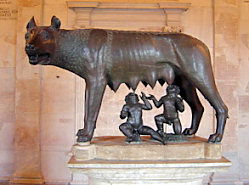
 Occasionally
throughout our history, civilized society has come across a "wild child"
who has grown up in isolation with virtually no human contact. Many
researchers believe that we're born with the principles of language, but
if a first language isn't acquired by puberty it may be too late -- we
just don't have the neurological development. It also appears that there's
a particular period in the life of humans when they're ripe for learning
languages. Studies of feral children who have had little contact with humans
during the critical ages of one through four years show that they've had
tremendous difficulty mastering language and reintegrating with humans.
Occasionally
throughout our history, civilized society has come across a "wild child"
who has grown up in isolation with virtually no human contact. Many
researchers believe that we're born with the principles of language, but
if a first language isn't acquired by puberty it may be too late -- we
just don't have the neurological development. It also appears that there's
a particular period in the life of humans when they're ripe for learning
languages. Studies of feral children who have had little contact with humans
during the critical ages of one through four years show that they've had
tremendous difficulty mastering language and reintegrating with humans.



